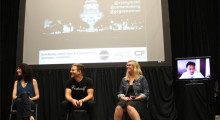DCP
-
Progress in Small Steps: Camera and Lighting Technology Trends in 2023

Commercial theatrical projection for most folks is an afterthought. A DCP gets loaded into a playout server, sound levels checked, curtains adjusted, and everything is good to go. This testifies to the efficacy of the two-decade old DCP (Digital Cinema Package) container format. However, DCP adoption was not always smooth sailing. In 2009, a necessary DCP revamp complicated the industry’s transition away from 35mm. The original “Interop” specification, which had only been provisional, was superseded by a set of standardized specifications from the Society of Motion Picture and Television Engineers (SMPTE). Interop supported only one frame rate, 24 fps, but […]
by David Leitner on Dec 15, 2023 -
How to Deliver Your Film to a Festival (2018 Edition)

Back in 2015, I wrote an article for Filmmaker on the best practices for delivering an exhibition copy of your film to festivals. In the ensuing two and a half, almost three years, I’ve received a lot of positive feedback, including a few panicked emails from filmmakers submitting their films to a festivals I worked at. Now in 2018, my editors have asked me to update it. Why the update now? Allow me the use of a clumsy and imperfect technical reference to Moore’s law that computing power doubles every eighteen months and the same has happened to available filmmaking […]
by Sergio Andrés Lobo-Navia on May 1, 2018 -
How a DCP Gets Made

“I was once Inside Llewyn Davis. Now I am Mad Max: Fury Road.” I came up with that Instagram caption while working a festival in suburban New Jersey last spring. Toward the end of the festival, UPS made a delivery of a couple of battered Deluxe/Technicolor cases that had seen better days. The label on the box read Tina’s Heroes, which was the secret title that Warner Brothers shipped Mad Max to theaters as. I chuckled at the reference to the hit song from Beyond Thunderdome, and then I looked at all of the other labels. There was a large piece of […]
by Sergio Andrés Lobo-Navia on Apr 21, 2016 -
Long-Term Care: How to Archive Your Film

Your film is done. Audiences have laughed and cried while watching it. You got a week-long run in New York and Los Angeles. Soon your aunt in Springfield will be able to watch it on Netflix and have a strained telephone conversation about how “interesting” it is. On to the next project! Not so fast. You need to archive your film now. Put down your storyboard for your next picture and help preserve your old one first. The Film Foundation estimates that “one half of all films made before 1950, and over 80 percent made before 1929 are lost forever.” […]
by Sergio Andrés Lobo-Navia on Jan 20, 2016 -
How to Deliver Your Film to a Festival

Note (May 2018): the updated version of this article can be found here. Format. Codec. Audio. DCP. You’ve worked on your movie now for some time and have been eagerly waiting for acceptance emails from festivals. One lands in your inbox, and you excitedly read through the letter until, when you get to the festival’s technical requirements, you develop a sense of dread. The tersely worded communication from the technical director (glad we could finally meet) would put you to sleep if it didn’t terrify you. But don’t panic. Instead, phone your editor, and read this guide. Caveat emptor, though: […]
by Sergio Andrés Lobo-Navia on Oct 28, 2015 -
#ArtistServices Austin Workshop: Talking Crowdfunding, Torrents, DCP and More

Sundance often faces criticism from the independent film community as being inaccessible and too commercial. Two weekends ago Austin Studios, the Sundance Institute and the Austin Film Society held the sold-out “#ArtistServices Austin Workshop,” proving Robert Redford’s initial vision of supporting truly indie film is strongly intact. The day-long event was focused on educating filmmakers about the business side of fundraising, marketing, and distribution for small movies. Filled with local filmmakers like Two Step director Alex Johnson and Before You Know It director PJ Raval and producer Annie Bush, the raw hanger space (Austin Studios is located on the site […]
by Eric M. Levy on May 20, 2014
